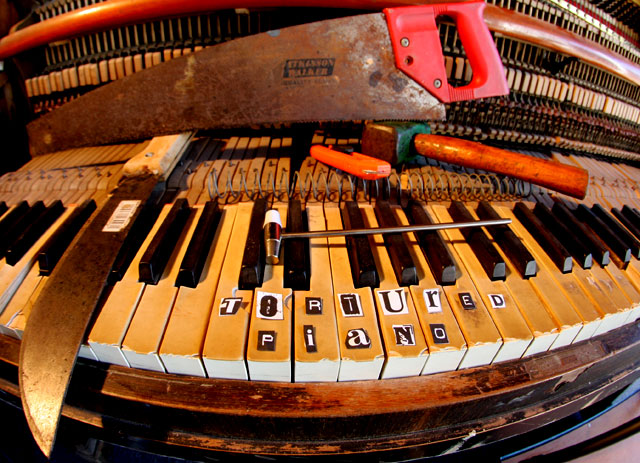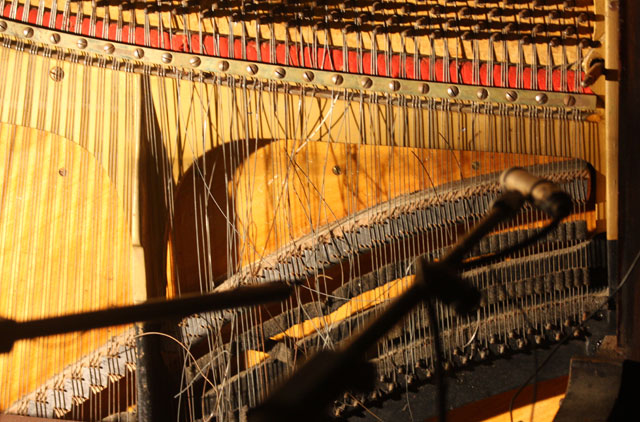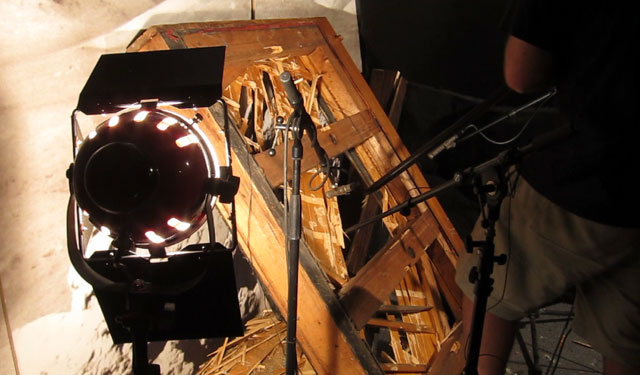
HISS and a ROAR has released TORTURED PIANO, a new library loaded with 1,143 sound design sources recorded through the destruction of a dilapidated old upright piano.
The library is a huge collection recorded and mastered at 24-Bit/192kHz (total of 7.3GB). The content is diverse and unique, offering all kind of sounds recored with different microphones and a wide variety of performances. Also includes recordings of a baby grand piano using contact microphones. I’t’s available at $79 (until May 20. Then at $99).
There is nothing sadder than the death of a musical instrument, but this broken old piano was deceased long before I got it. So my mission was to immortalise its final sounds as it was struck, scraped, twanged, hit and slowly deconstructed to a pile of kindling and broken wires. And then a wake was held….
The resulting library is an incredibly diverse collection of disturbing and unsettling sounds, perfect for evocative sound design but also useful for many practical applications: some of the wood creaks, shrieks, hits & splits are particularly resonant, while many of the metal-on-wood scrapes are prime source material for woosh creation.
Let’s hear some sounds:
[soundcloud url=”http://api.soundcloud.com/tracks/14602412″]
[soundcloud url=”http://soundcloud.com/timprebble/tortured-piano-preview-02-fx”]
[soundcloud url=”http://api.soundcloud.com/tracks/14602569″]
As usual, Tim Prebble, responsible of this fantastic release, shares with us the stories behind this unique recording adventure.
DS: What inspired the library?
TP: I’ve always been fascinated by how the piano is sometimes categorized as a percussion instrument. And I’ve always loved the range of sounds possible with a prepared piano so I decided to take it to an extreme. Some of the sounds I imagined would involve actual destruction of the piano, and I like playing my baby grand piano so I started hunting for an old upright that was beyond repair. I wasn’t prepared to sacrifice an actual instrument still capable of bringing joy to someone, so back in January I came across a zombie piano – it was literally the living dead!
 DS: Recording must have taken some strategic planning?
DS: Recording must have taken some strategic planning?
TP: Indeed, you cannot uncut a string. When I first started recording with the piano I soon realized that every sound would have resonating strings on it, up until when all the strings were cut. So I worked in two distinct stages, first extracting every interesting sound I could while the strings & resonating sound board were intact. Then after cutting the strings one by one the second stage meant it became more of an inanimate object & I could properly start dismantling & torturing it for discrete sounds.
DS: What gear did you use?
TP: I recorded the upright piano to six channels: a pair of Oktava MK012s, a pair of DPA 4060s and two Barcus Berry Planar Wave contact mics. These were recorded to my Sound Devices 744 with the 722 C-Locked to it. When outputting the library I chose the best combination of sources and mixed them, partly to keep the overall size of the library manageable but also because at times all the contact mics were contributing was low frequencies which weren’t interesting on their own.
DS: And you did a separate contact mic recording session with another piano, right?
TP: After listening through all the material from the upright piano recording I was a little dissatisfied with the contact mics – they really require specific attention and monitoring to get really great results. They also respond the best to more subtle gestures on resonant bodies, rather than loud and fairly dynamic impacts. So I did two sessions with my baby grand piano, where I was only recording and listening to the contact mics, and that made all the difference. Contact mics are wonderful at extreme amplification, even sliding my hand gently across the bass strings could generate really massive sounds, so you have to experiment a lot and be radically resetting your gain control for each set up.

DS: What are some of your favorite sounds from the library?
TP: I recorded quite a few clusters of notes, not because they are necessarily interesting in themselves but when reversed they become very useful (I was tempted to reverse them for the final library release, but instead left them forwards & made a note in the metadata). Cutting strings was also interesting – when you combine the tension of all the strings there is a huge amount of pressure across the soundboard of a piano. After i finished recording hits & scrapes on the strings I worked my way through all the strings, cutting them one by one. But I kept two bass strings until last, and it was weird – I was really hesitant to cut the last string, as that really meant the end of the piano. So I did a lot of scrapes & plucks with those last two bass strings – sounds thats you would never perform on a ‘normal’ piano due to fear of damaging it. I then recorded a lot of great wood impacts and splits but some of the creaks & shrieks are really very strange. I guess its due to the particular type of wood used in the sound board but at times its almost vocal, and some are very, very shrill…. & played at quarter speed are quite haunting….
[vimeo]http://vimeo.com/23147223[/vimeo]
My two favorite sounds from the contact mic sessions were first with gaffer tape. I had always planned to record the sound of gaffer tape being pulled from the strings, as I figured its like an interesting way of exciting the strings, almost like a very strange non-linear granular bow. But when I had a big strip of gaffer tape on some bass strings I started playing with a screwdriver, pressing so hard into the gaffer tape that it was almost piercing it. There is something really fantastic about the tonality of the resulting sound – the ratchet effect of the strings is subdued via the gaffer tape, but the friction creates lots of resonant slow frequencies. The other contact mic sound I really like is the spring ratchets – I wedged quite a big spring into the strings , and then dragged an implement (a drum stick with a piano hammer attached to it) across the spring, creating these really slow & powerful decelerating ratchets. I think what appeals with these sounds are that they weren’t preconceived – they were found through experimentation, and in the end it was the prop that suggested them.
DS: Whats next for release on HISSandaROAR?
TP: I have a WATER FOLEY library very near finished. I’ve finished three recording sessions in exterior swimming pools as well as recording footsteps in ponds, lakes, mud holes & at the beach – all sounds that are impossible to recreate on a foley stage. After that will be a SPRINGS library followed by a RESONANT METAL library which I have some very unusual ideas about both recording and processing. Serious fun!
[vimeo]http://vimeo.com/22797167[/vimeo]
What an absolutely fantastic library. I’m drooling at plethora of sounds that could be created from that.
Tim, you should totally win an award for the coolest and most useful sound effects library for this. Great stuff! Cant wait to play with some of those sounds..
thanks for the kind words! I can’t wait to use it in a project too!
Good work on the library!
On the topic of tortured pianos, there’s also a more performance-based recording by Diego Stocco http://vimeo.com/1747614
Not sure if that was ever turned into a library.